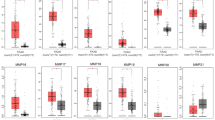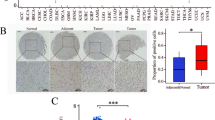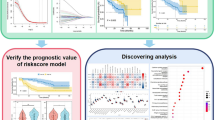Summary
We and other researchers have previously found that colony-stimulating factors (CSFs), which generally include granulocyte colony-stimulating factor (G-CSF), granulocyte–macrophage colony-stimulating factor (GM-CSF) and macrophage colony-stimulating factor (M-CSF), promote invasion by lung cancer cells. In the present study, we studied the effects of these CSFs on gelatinase production, urokinase plasminogen activator (uPA) production and their activity in human lung cancer cells. Gelatin zymographs of conditioned media derived from human lung adenocarcinoma cell lines revealed two major bands of gelatinase activity at 68 and 92 kDa, which were characterized as matrix metalloproteinase (MMP)-2 and MMP-9 respectively. Treatment with CSFs increased the 68- and 92-kDa activity and converted some of a 92-kDa proenzyme to an 82-kDa enzyme that was consistent with an active form of the MMP-9. Plasminogen activator zymographs of the conditioned media from the cancer cells showed that CSF treatment resulted in an increase in a 48–55 kDa plasminogen-dependent gelatinolytic activity that was characterized as human uPA. The conditioned medium from the cancer cells treated with CSFs stimulated the conversion of plasminogen to plasmin, providing a direct demonstration of the ability of enhanced uPA to increase plasmin-dependent proteolysis. The enhanced invasive behaviour of the cancer cells stimulated by CSFs was well correlated with the increase in MMPs and uPA activities. These data suggest that the enhanced production of extracellular matrix-degrading proteinases by the cancer cells in response to CSF treatment may represent a biochemical mechanism which promotes the invasive behaviour of the cancer cells.
Similar content being viewed by others
Article PDF
Change history
16 November 2011
This paper was modified 12 months after initial publication to switch to Creative Commons licence terms, as noted at publication
References
Bukowski, R. M., Budd, G. T., Gibbons, J. A., Bauer, R. J., Childs, A., Antal, J., Finke, J., Tuason, L., Lorenzi, V. & McLain, D. et al (1994). Phase I trial of subcutaneous recombinant macrophage colony-stimulating factor: clinical and immunomodulatory effects. J Clin Oncol 12: 97–106.
Chambers, S. K., Wang, Y., Gertz, R. E. & Kacinski, B. M. (1995). Macrophage colony-stimulating factor mediates invasion of ovarian cancer cells through urokinase. Cancer Res 55: 1578–1585.
Cubellis, M. V., Wun, T. C. & Blasi, F. (1990). Receptor-mediated internalization and degradation of urokinase is caused by its specific inhibitor PAI-1. EMBO J 9: 1079–1085.
Filderman, A. E., Bruckner, A., Kacinski, B. M., Deng, N. & Remold, H. G. (1992). Macrophage colony-stimulating factor (CSF-1) enhances invasiveness in CSF-1 receptor-positive carcinoma cell lines. Cancer Res 52: 3661–3666.
Hamilton, J. A., Vairo, G., Knight, K. R. & Cocks, B. G. (1991). Activation and proliferation signals in murine macrophages. Biochemical signals controlling the regulation of macrophage urokinase-type plasminogen activator activity by colony-stimulating factors and other agents. Blood 77: 616–627.
Harmenberg, J., Hoglund, M. & Hellstrom-Lindberg, E. (1994). G- and GM-CSF in oncology and oncological haematology. Eur J Haematol 52: 1–28.
Hart, P. H., Vitti, G. F., Burgess, D. R., Whitty, G. A., Royston, K. & Hamilton, J. A. (1990). Activation of human monocytes by granulocyte-macrophage colony-stimulating factor: increased urokinase-type plasminogen activator activity. Blood 77: 841–848.
Hekman, C. M. & Loskutoff, D. J. (1985). Endothelial cells produce a latent inhibitor of plasminogen activators that can be activated by denaturants. J Biol Chem 260: 11581–11587.
Herlyn, M. & Malkowicz, S. B. (1991). Regulatory pathways in tumor growth and invasion. Lab Invest 65: 262–27.
Jeffers, M., Rong, S. & Vande Woude, G. F. (1996). Enhanced tumorigenicity and invasion-metastasis by hepatocyte growth factor/scatter factor-met signalling in human cells concomitant with induction of the urokinase proteolysis network. Mol Cell Biol 16: 1115–1125.
Koshikawa, N., Yasumitsu, H., Umeda, M. & Miyazaki, K. (1992). Multiple secretion of matrix serine proteinases by human gastric carcinoma cell lines. Cancer Res 52: 5046–5053.
Liotta, L. A., Steeg, P. S. & Stetler-Stevenson, W. G. (1991). Cancer metastasis and angiogenesis: an imbalance of positive and negative regulation. Cell 64: 327–336.
Michel, J. B. & Quertermous, T. (1989). Modulation of mRNA levels for urinary- and tissue-type plasminogen activator and plasminogen activator inhibitors 1 and 2 in human fibroblasts by interleukin 1. J Immunol 143: 890–895.
Mignatti, P. & Rifkin, D. B. (1993). Biology and biochemistry of proteinases in tumor invasion. Physiol Rev 73: 161–195.
Murphy, G. & Crabbe, T. (1995). Gelatinases A and B. Methods Enzymol 248: 471–528.
Niedbala, M. J. & Picarella, M. S. (1991). Tumor necrosis factor induction of endothelial cell urokinase-type plasminogen activator mediated proteolysis of extracellular matrix and its antagonism by γ-interferon. Blood 79: 678–687.
Niedbala, M. J. & Stein, M. (1991). Tumor necrosis factor induction of urokinase-type plasminogen activator in human endothelial cells. Biomed Biochim Acta 50: 427–436.
Pei, X. H., Nakanishi, Y., Takayama, K., Yatsunami, J., Bai, F., Kawasaki, M., Wakamatsu, K., Tsuruta, N., Mizuno, K. & Hara, N. (1996). Granulocyte-colony stimulating factor promotes invasion by human lung cancer cell lines in vitro. Clin Exp Metastasis 14: 351–357.
Pei, X. H., Nakanishi, Y., Takayama, K., Bai, F., Kawasaki, M. & Hara, N. (1998). G-CSF increases secretion of urokinase-type plasminogen activator by human lung cancer cells. Clin Exp Metastasis,
Petersen, L. C., Lund, L. R., Nielsen, L. S., Dano, K. & Skriver, L. (1988). One chain urokinase-type plasminogen activator from human sarcoma cells is a proenzyme with little or no intrinsic activity. J Biol Chem 263: 11189–11195.
Ries, C. & Petrides, P. E. (1995). Cytokine regulation of matrix metalloproteinase activity and its regulatory dysfunction in disease. Biol Chem Hoppe-Seyler 376: 345–355.
Roche, P. C., Campeau, J. D. & Shaw, S. T. (1983). Comparative electrophoretic analysis of human and porcine plasminogen activators in SDS-polyacrylamide gels containing plasminogen and casein. Biochim Biophys Acta 745: 82–89.
Shapiro, S. D., Fliszar, C. J., Broekelmann, T. J., Mecham, R. P., Senior, R. M. & Welgus, H. G. (1995). Activation of the 92-kDa gelatinase by stromelysin and 4-aminophenylmercuric acetate. J Biol Chem 270: 6351–6356.
Shimizu, S., Nishikawa, Y., Kuroda, K., Takagi, S., Kozaki, K., Hyuga, S., Saga, S. & Matsuyama, M. (1996). Involvement of transforming growth factor β1 in autocrine enhancement of gelatinase B secretion by murine metastatic colon carcinoma cells. Cancer Res 56: 3366–3370.
Stacey, K. J., Fowles, L. F., Colman, M. C., Ostrowski, M. C. & Hume, D. A. (1995). Regulation of urokinase-type plasminogen activator gene transcription by macrophage colony-stimulating factor. Mol Cell Biol 15: 3430–3441.
Stearns, M. E. & Wang, M. (1994). Immunoassays of the metalloproteinase (MMP-2) and tissue inhibitor of metalloproteinase (TIMP 1 and 2) levels in noninvasive and metastatic PC-3 clones: effects of taxol. Oncol Res 6: 195–201.
Stetler-Stevenson, W. G. (1990). Type IV collagenases in tumor invasion and metastasis. Cancer Metastasis Rev 9: 289–303.
Testa, J. E. & Quigley, J. P. (1990). The role of urokinase-type plasminogen activator in aggressive tumor cell behavior. Cancer Metastasis Rev 9: 353–367.
Teti, A., De Giorgi, A., Spinella, M. T., Migliaccio, S., Canipari, R., Onetti Muda, A. & Faraggiana, T. (1997). Transforming growth factor-beta enhances adhesion of melanoma cells to the endothelium in vitro. Int J Cancer 72: 1013–1020.
Tsuruta, N., Yatsunami, J., Takayama, K., Nakanishi, Y., Ichinose, Y. & Hara, N. (1998). Granulocyte–macrophage colony-stimulating factor stimulates tumor invasiveness in squamous cell lung cancer. Cancer (in press)
Vose, J. M. & Armitage, J. O. (1995). Clinical applications of hematopoietic growth factors. J Clin Oncol 13: 1023–1035.
Weimar, I. S., De Jong, D., Muller, E. J., Nakamura, T., Van Gorp, J., De Gast, G. C. & Gerritsen, W. R. (1997). Hepatocyte growth factor/scatter factor promotes adhesion of lymphoma cells to extracellular matrix molecules via alpha 4 beta 1 and alpha 5 beta 1 integrins. Blood 89: 990–1000.
Young, M. R. I., Lozano, Y., Djordjevic, A., Devata, S., Matthews, J., Young, M. E. & Wright, M. A. (1993). Granulocyte–macrophage colony-stimulating factor stimulates the metastatic properties of Lewis lung carcinoma cells through a protein kinase A signal-transduction pathway. Int J Cancer 53: 667–671.
Zhang, M., Wang, M. H., Singh, R. K., Wells, A. & Siegal, G. P. (1997). Epidermal growth factor induces CD44 gene expression through a novel regulatory element in mouse fibroblasts. J Biol Chem 272: 14139–14146.
Author information
Authors and Affiliations
Rights and permissions
From twelve months after its original publication, this work is licensed under the Creative Commons Attribution-NonCommercial-Share Alike 3.0 Unported License. To view a copy of this license, visit http://creativecommons.org/licenses/by-nc-sa/3.0/
About this article
Cite this article
Pei, XH., Nakanishi, Y., Takayama, K. et al. Granulocyte, granulocyte–macrophage, and macrophage colony-stimulating factors can stimulate the invasive capacity of human lung cancer cells. Br J Cancer 79, 40–46 (1999). https://doi.org/10.1038/sj.bjc.6690009
Received:
Revised:
Accepted:
Published:
Issue date:
DOI: https://doi.org/10.1038/sj.bjc.6690009
Keywords
This article is cited by
-
An epithelial-to-mesenchymal transition-inducing potential of granulocyte macrophage colony-stimulating factor in colon cancer
Scientific Reports (2017)
-
Stimulatory versus suppressive effects of GM-CSF on tumor progression in multiple cancer types
Experimental & Molecular Medicine (2016)
-
Prognostic impact of CD57, CD68, M-CSF, CSF-1R, Ki67 and TGF-beta in soft tissue sarcomas
BMC Clinical Pathology (2012)
-
Synergistic effect of SCF and G-CSF on stem-like properties in prostate cancer cell lines
Tumor Biology (2012)
-
Serum macrophage colony-stimulating factor (M-CSF) in patients with Hodgkin lymphoma
Medical Oncology (2012)



